Heterotrimeric Gα-subunit regulates flower and fruit development in CLAVATA signaling pathway in cucumber
- PMID: 38898960
- PMCID: PMC11186068
- DOI: 10.1093/hr/uhae110
Heterotrimeric Gα-subunit regulates flower and fruit development in CLAVATA signaling pathway in cucumber
Abstract
Flowers and fruits are the reproductive organs in plants and play essential roles in natural beauty and the human diet. CLAVATA (CLV) signaling has been well characterized as regulating floral organ development by modulating shoot apical meristem (SAM) size; however, the signaling molecules downstream of the CLV pathway remain largely unknown in crops. Here, we found that functional disruption of CsCLV3 peptide and its receptor CsCLV1 both resulted in flowers with extra organs and stumpy fruits in cucumber. A heterotrimeric G protein α-subunit (CsGPA1) was shown to interact with CsCLV1. Csgpa1 mutant plants derived from gene editing displayed significantly increased floral organ numbers and shorter and wider fruits, a phenotype resembling that of Csclv mutants in cucumber. Moreover, the SAM size was enlarged and the longitudinal cell size of fruit was decreased in Csgpa1 mutants. The expression of the classical stem cell regulator WUSCHEL (WUS) was elevated in the SAM, while the expression of the fruit length stimulator CRABS CLAW (CRC) was reduced in the fruit of Csgpa1 mutants. Therefore, the Gα-subunit CsGPA1 protein interacts with CsCLV1 to inhibit floral organ numbers but promote fruit elongation, via repressing CsWUS expression and activating CsCRC transcription in cucumber. Our findings identified a new player in the CLV signaling pathway during flower and fruit development in dicots, increasing the number of target genes for precise manipulation of fruit shape during crop breeding.
© The Author(s) 2024. Published by Oxford University Press on behalf of Nanjing Agricultural University.
Conflict of interest statement
The authors declare no conflict of interest.
Figures
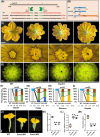
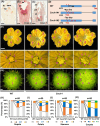
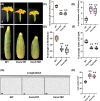
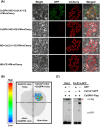
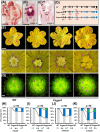



Similar articles
-
Gene regulatory network controlling carpel number variation in cucumber.Development. 2020 Apr 6;147(7):dev184788. doi: 10.1242/dev.184788. Development. 2020. PMID: 32165491
-
The CLV-WUS Stem Cell Signaling Pathway: A Roadmap to Crop Yield Optimization.Plants (Basel). 2018 Oct 19;7(4):87. doi: 10.3390/plants7040087. Plants (Basel). 2018. PMID: 30347700 Free PMC article. Review.
-
CsLFY is required for shoot meristem maintenance via interaction with WUSCHEL in cucumber (Cucumis sativus).New Phytol. 2018 Apr;218(1):344-356. doi: 10.1111/nph.14954. Epub 2017 Dec 23. New Phytol. 2018. PMID: 29274285
-
ENO regulates tomato fruit size through the floral meristem development network.Proc Natl Acad Sci U S A. 2020 Apr 7;117(14):8187-8195. doi: 10.1073/pnas.1913688117. Epub 2020 Mar 16. Proc Natl Acad Sci U S A. 2020. PMID: 32179669 Free PMC article.
-
Plant meristems: CLAVATA3/ESR-related signaling in the shoot apical meristem and the root apical meristem.J Plant Res. 2009 Jan;122(1):31-9. doi: 10.1007/s10265-008-0207-3. Epub 2008 Dec 23. J Plant Res. 2009. PMID: 19104754 Review.
Cited by
-
SlKNUCKLES regulates floral meristem activity and controls fruit size in Solanum lycopersicum.Hortic Res. 2024 Nov 21;12(3):uhae331. doi: 10.1093/hr/uhae331. eCollection 2025 Mar. Hortic Res. 2024. PMID: 40046322 Free PMC article.
-
Comprehensive Analysis of Hormonal Signaling Pathways and Gene Expression in Flesh Segment Development of Chinese Bayberry (Myrica rubra).Plants (Basel). 2025 Feb 13;14(4):571. doi: 10.3390/plants14040571. Plants (Basel). 2025. PMID: 40006830 Free PMC article.
-
Discovery of variation in genes related to agronomic traits by sequencing the genome of Cucurbita pepo varieties.BMC Genomics. 2025 Apr 3;26(1):335. doi: 10.1186/s12864-025-11370-x. BMC Genomics. 2025. PMID: 40181258 Free PMC article.
-
Integration of bulked segregant analysis and transcriptome sequencing reveals an interaction network associated with cluster buds trait in Brassica napus.Theor Appl Genet. 2025 Aug 6;138(8):200. doi: 10.1007/s00122-025-04989-7. Theor Appl Genet. 2025. PMID: 40767971
-
Mining the cucumber core collection: phenotypic and genetic characterization of morphological diversity for fruit quality characteristics.Hortic Res. 2024 Dec 4;12(3):uhae340. doi: 10.1093/hr/uhae340. eCollection 2025 Mar. Hortic Res. 2024. PMID: 40061803
References
-
- Galli M, Gallavotti A. Expanding the regulatory network for meristem size in plants. Trends Genet. 2016;32:372–83 - PubMed
-
- Ha CM, Jun JH, Fletcher JC. Shoot apical meristem form and function. Curr Top Dev Biol. 2010;91:103–40 - PubMed
-
- Fletcher JC, Brand U, Running MP. et al. Signaling of cell fate decisions by CLAVATA3 in Arabidopsis shoot meristems. Science. 1999;283:1911–4 - PubMed
-
- Clark SE, Williams RW, Meyerowitz EM. The CLAVATA1 gene encodes a putative receptor kinase that controls shoot and floral meristem size in Arabidopsis. Cell. 1997;89:575–85 - PubMed
-
- Ogawa M, Shinohara H, Sakagami Y. et al. Arabidopsis CLV3 peptide directly binds CLV1 ectodomain. Science. 2008;319:294. - PubMed
LinkOut - more resources
Full Text Sources

